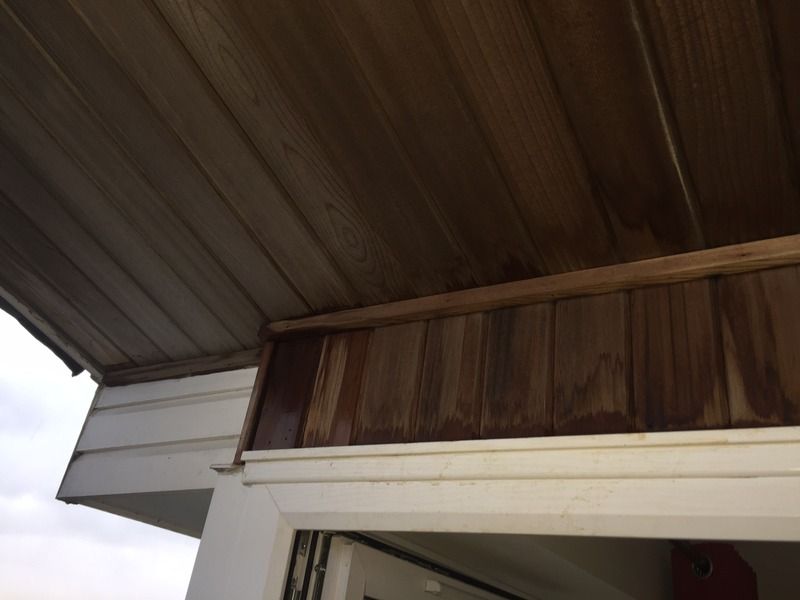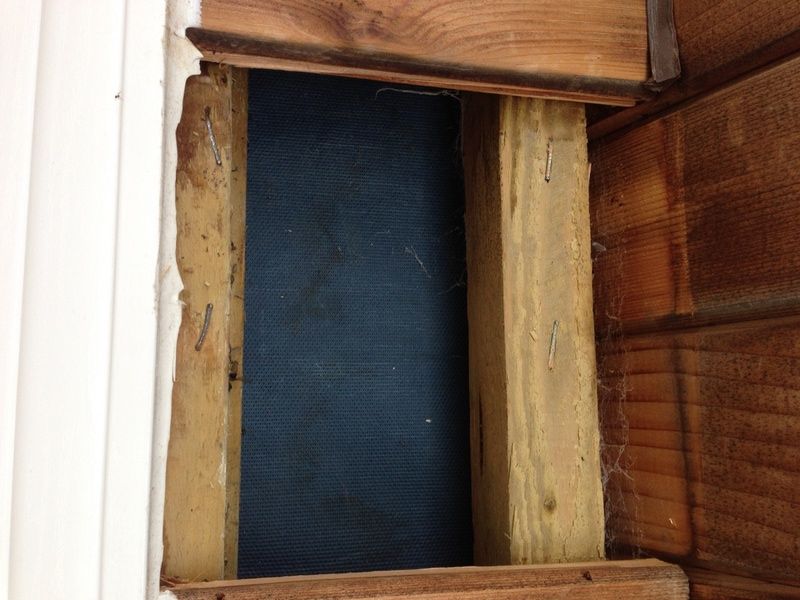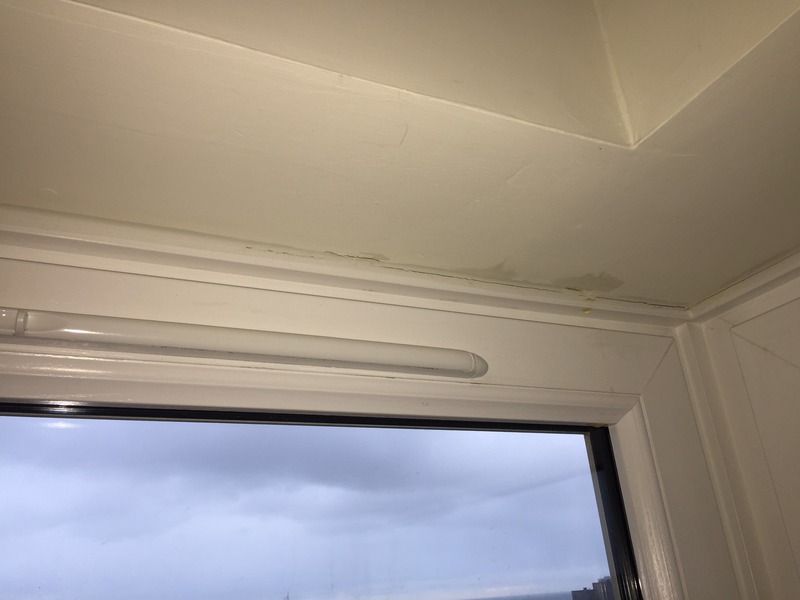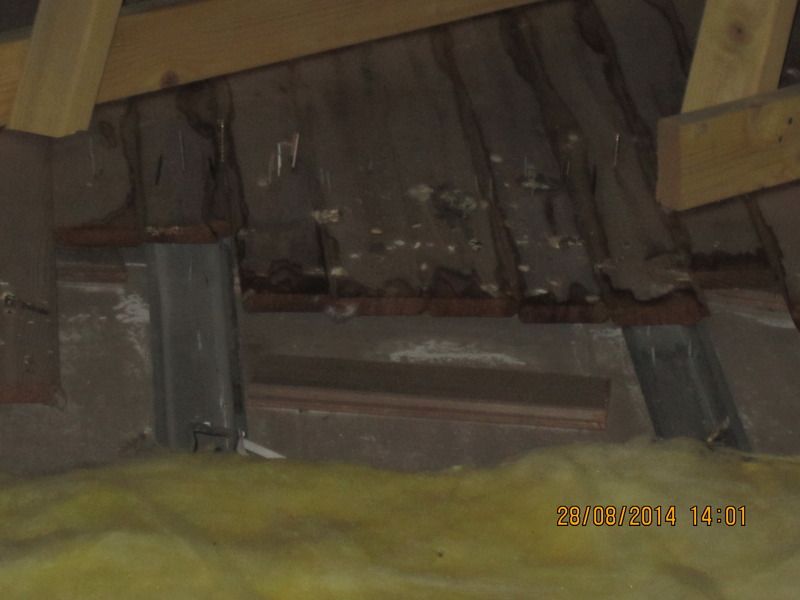We’d like to remind Forumites to please avoid political debate on the Forum.
This is to keep it a safe and useful space for MoneySaving discussions. Threads that are – or become – political in nature may be removed in line with the Forum’s rules. Thank you for your understanding.
📨 Have you signed up to the Forum's new Email Digest yet? Get a selection of trending threads sent straight to your inbox daily, weekly or monthly!
Red Cedar Cladding

missile
Posts: 11,813 Forumite






I have red cedar cladding on my home. In very bad weather we get water penetration in two areas.
I believe the design / installation is not correct and the damp proof membrane has not been properly installed. It would be extremely difficult and expensive to remove the cladding, modify the design and replace the membrane.
Can anyone recommend an external waterproofing surface treatment for the cladding?
I believe the design / installation is not correct and the damp proof membrane has not been properly installed. It would be extremely difficult and expensive to remove the cladding, modify the design and replace the membrane.
Can anyone recommend an external waterproofing surface treatment for the cladding?
"A nation's greatness is measured by how it treats its weakest members." ~ Mahatma Gandhi
Ride hard or stay home :iloveyou:
Ride hard or stay home :iloveyou:
0
Comments
-
Western Red Cedar has a unique cell structure. When we make glasshouses and the timber is delivered its literally dripping with water but within a day or two its very dry but its very ,very soft . Fixing it is easy but should be done with Stainless Steel fixings and the problem you will have is if its been nailed you will need to punch the nails right in to release the boards otherwise it will be damaged very easily.
If you are 100% sure its down to poor fitting building wrap/membrane then I would seriously consider taking the boards off. You can't treat the timber with silicone spray products so taking the boards off is your best bet ,in my opinion but others may have other ideas..When used to clad dwellings you would usually clad the building in wrap, then fix 2x1 tanalised battens onto the wrap and fix the cladding to the batten.This creates an airflow which helps the cladding shed water and stops moisture ingress..
Have you got any photo's?.0 -
I reckon leveller2911 is right. I doubt very much if anything apart from taking the cladding off, and fixing the problem(s) will achieve anything. I'd want to be absolutely sure that the water isn't getting in from somewhere that is repairable first though, but finding leaks like these is notoriously difficult.0
-
leveller2911 wrote: »......... Have you got any photo's?.
Our property is top of a six storey block
The detail is the roof cladding extends beyond the wall cladding
We have already had the builder remove the cladding and attempt a repair
The water penetrating is coloured from the red cedar "A nation's greatness is measured by how it treats its weakest members." ~ Mahatma Gandhi
"A nation's greatness is measured by how it treats its weakest members." ~ Mahatma Gandhi
Ride hard or stay home :iloveyou:0 -
It's a very strange place to be getting water staining on the timber with such a large overhang, does your neighbour have a similar issue?
It looks to me like water is tracking along the soffit boards onto the wall rather than it being an issue with the wall cladding - could be wrong but I've only seen three photos!!This is a system account and does not represent a real person. To contact the Forum Team email forumteam@moneysavingexpert.com0 -
Only when there is very heavy rain and driving wind do we have a problem. The water appears to curl round the overhang and track down the boards and penetrate the joint where they extend beyond the vertical boards.
To my mind, if those vertical boards terminated and the vertical boards extended it would provide a better seal. However this could limit expansion of the overhanging boards.
This is the only building with this unique design and I guess the architect did not anticipate this would be an issue.
This photo may give you a better understanding of the design? "A nation's greatness is measured by how it treats its weakest members." ~ Mahatma Gandhi
"A nation's greatness is measured by how it treats its weakest members." ~ Mahatma Gandhi
Ride hard or stay home :iloveyou:0 -
The cedar cladding is acting as a rainscreen and is open jointed therefore it is not designed to be watertight - the membrane will be designed to do that. Is: if the cladding did not exist the membrane should be preventing water ingress. Fixing cladding through membranes can tear it and therefore undermine it. There should be a continuous membrane from the soffit down the wall.
Where the water appears to be leaking in is around the windows, it may simply be that the dpc or EPDM is failing, has anyone checked local to the lintel?
If it is water tracking back in then adding a drip to the timber soffit will help and could be less intrusive than removing all of the cladding and all of the supports to fix a tear in the membrane or insert a new one.
Does it have a drip at present hard to see from the pictures.
Actually you are on the top, so it could even be the roof failing, too much water pooling or the gutter.
Really as it's building fabric you should be contacting your building management company to fix it - the external walls / windows / roof are not yours to fix, unless you have a share of freehold and then you need to consult with the other freeholders.0 -
Please be advisedlush_walrus wrote: »The cedar cladding is acting as a rainscreen and is open jointed therefore it is not designed to be watertight - the membrane will be designed to do that. Is: if the cladding did not exist the membrane should be preventing water ingress. Fixing cladding through membranes can tear it and therefore undermine it. There should be a continuous membrane from the soffit down the wall. The membrane terminates at the joint between the vertical and overhanging boards, please see photo.
Where the water appears to be leaking in is around the windows, it may simply be that the dpc or EPDM is failing, has anyone checked local to the lintel? The water penetrates in the plasterboard which is higher than the windows, please see photo.
If it is water tracking back in then adding a drip to the timber soffit will help and could be less intrusive than removing all of the cladding and all of the supports to fix a tear in the membrane or insert a new one. The membrane was exposed when builder attempted repair and it appears to be sound.
Does it have a drip at present hard to see from the pictures. It is hard to show a water drip in a photo. There is a significant amount of water penetration, resulting in water pooling on the floor
Actually you are on the top, so it could even be the roof failing, too much water pooling or the gutter. The staining of the water matches the red cedar which is a clear indication water is coming in via the cladding.
Really as it's building fabric you should be contacting your building management company to fix it - the external walls / windows / roof are not yours to fix, unless you have a share of freehold and then you need to consult with the other freeholders. We have already had the builder attempt repairs."A nation's greatness is measured by how it treats its weakest members." ~ Mahatma Gandhi
Ride hard or stay home :iloveyou:0 -
yeah, it's just a bad detail tbh - either the facia on the roof should have had a big enough drip edge to make sure there wouldn't be anything getting onto the soffit or there should have been a better detailed junction at your vertical cladding.
One way to fix it might be to rout a channel into your soffit board just before the joint with the vertical, just a little deeper than the groove in the boars - the full length of the joints, which would create a drip edge of sorts and would stop water tracking.
The more extreme fix would be to trim back the soffit cladding completely and put a proper downstand piece in, like an aluminium edge, to give a definite stop to any tracking waterThis is a system account and does not represent a real person. To contact the Forum Team email forumteam@moneysavingexpert.com0 -
As you suspect the junction between the sloping soffit and vertical cladding is wrong.
It looks like they boarded the soffit first taking the boards right back to the wall and then fixed the vertical cladding with the soffit running across the top. This creates a route for the water tracking back along the sloping soffit to bypass the vertical cladding and penetrate the building.
All that cladding will probably have to be taken off and redone with a new joint detail, expensive job. It looks like a newish building so it's possibly a claim against the freeholder/builder/designer as a latent defect.0 -
Some great ideas, many thanks :Athe_r_sole wrote: »yeah, it's just a bad detail tbh - either the facia on the roof should have had a big enough drip edge to make sure there wouldn't be anything getting onto the soffit or there should have been a better detailed junction at your vertical cladding. The drip edge on the facia is very small. We did install a gutter the perimeter. This reduced but has not eliminated rain water contacting the soffit boards. You can just see it on one of the photos.
One way to fix it might be to rout a channel into your soffit board just before the joint with the vertical, just a little deeper than the groove in the boars - the full length of the joints, which would create a drip edge of sorts and would stop water tracking. The groove would be circa half board thickness and I doubt that would work. I have appended a photo from inside the loft which shows water straining on the upper side of the soffit boards. Perhaps a run of silicon running across the grain of the soffits would provide a drip edge?
The more extreme fix would be to trim back the soffit cladding completely and put a proper downstand piece in, like an aluminium edge, to give a definite stop to any tracking water I shall investigate that option
 "A nation's greatness is measured by how it treats its weakest members." ~ Mahatma Gandhi
"A nation's greatness is measured by how it treats its weakest members." ~ Mahatma Gandhi
Ride hard or stay home :iloveyou:0
This discussion has been closed.
Confirm your email address to Create Threads and Reply

Categories
- All Categories
- 352.8K Banking & Borrowing
- 253.9K Reduce Debt & Boost Income
- 454.7K Spending & Discounts
- 245.9K Work, Benefits & Business
- 602K Mortgages, Homes & Bills
- 177.8K Life & Family
- 259.8K Travel & Transport
- 1.5M Hobbies & Leisure
- 16K Discuss & Feedback
- 37.7K Read-Only Boards


